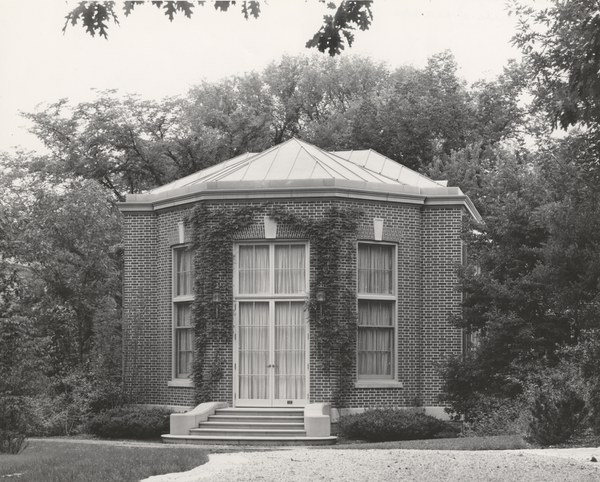The Garden Library, which houses the Rare Book Collection, was constructed in 1963–64 by the architect Frederick Rhinelander King. It was built on the site of the former service drive, along the southern face of the Museum Wing. Ruth Havey provided the landscaping for the garden areas surrounding the new library. Havey installed a series of Rococo-style winding walkways, called “ribbon walks,” and a birdbath garden surrounded by delicate plantings. Her plans originally called for the paths to extend into the South Lawn, but the ambitious design was not completed.
The Garden Library was a project that Mildred Bliss and Beatrix Farrand both pursued for many years. Beginning in 1940 with the gift of Dumbarton Oaks to Harvard University, Mildred Bliss turned her focus to amassing a well-rounded and respected collection of garden volumes, prints, drawings, manuscripts, and rare material. With help from Beatrix Farrand, Bliss searched for the highest possible quality of garden materials available for sale. She consulted with rare book dealers, librarians at institutions like the Harvard Library, Massachusetts Horticultural Society, and various national Arboretums, seeking recommendations of what a truly fine collection must contain. Within a few years, the collection had grown substantially. Mildred Bliss began to think about establishing a Garden Center where scholars could study gardens in the same way they studied Byzantine and pre-Columbian history at Dumbarton Oaks. At that time, her garden collection was split between rooms of the mansion, with rare and reference materials separated under the care of different librarians.
In the early 1950s, Bliss commissioned Dumbarton Oaks landscape architect Robert Patterson to draw up a series of proposed plans for a Garden Center, a building where researchers and collection could come together. Patterson offered her designs for a possible Garden Center located in one of three locations, in the re-purposed Cool House, on the site of the Tennis Court and an area north of the museum. The plans got so far as to receive estimates from G. Morris Steinbraker & Co., but Bliss passed on Patterson’s designs. By the time Frederick Rhinelander King was hired as architect, Patterson had moved on from Dumbarton Oaks, so the task of landscaping fell to Ruth Havey. While the Garden Archives hold very little correspondence from Havey during this period, her drawings for the ribbon walks are part of the collection. The ribbon walks, which are built of cut brick and carved limestone, simulate the quality of flowing cloth. Unfortunately, these walks seldom see visitors, because the eastern entrance to King’s Garden Library is no longer used.

